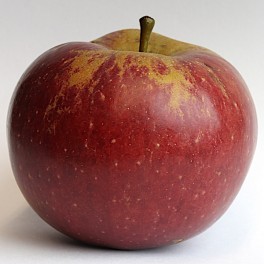More info
Blue Pearmain
Dessert apple
Thought to have originated in U.S.A. It was known in the early 1800s. Received an Award of Merit from the Royal Horticultural Society in 1893 and a First Class Certificate in 1896. Fruits have somewhat dry, rather soft, coarse-textured flesh with a sweet, pleasant aromatic flavour.
Shape: Truncate conical
Size: medium
Height: 63.00mm
Width: 70.00mm
Ground Colour: Green
Over Colour: Dark Red
Over Colour (Pattern): striped
Flesh Colour: Yellowish
Flowering time:
6th May 10% flowering
11th May Full (80%) flowering
17th May 90% petal fall
Picking time: Early October
Source: www.nationalfruitcollection.org.uk
The National Archives Open Government Licence
An excerpt from Beach’s Apples of New York, Volume 1:
BLUE PEARMAIN.
References. 1. Kenrick, 1833:42. 2. Manning, 1838:55. 3. Manning, Mag. Hort., 6:172. 1840. 4. Downing, 1845:122. 5. Phoenix, Horticulturist, 1:361. 1846. 6. Cole, 1849:120. 7. Thomas, 1849:164. 8. Emmons, Nat. Hist. N. Y., 3:69. 1851. col. pl. No. 54. 9. Hooper, 1857:19. 10. Elliott, 1858:122. 11. Am. Pom. Soc. Cat., 1862. 12. Barry, 1883:343. 13. Lyon, Mich. Hort. Soc. Rpt., 1890:288. 14. Bailey, An. Hort., 1892:235. 15. Waugh, Vt. Sta. An. Rpt., 14:289. 1901. 16. Can. Hort., 25:49. 1902. 17. Budd-Hansen, 1903:52. fig. 18. Beach and Clark, N. Y. Sta. Bul., 248:113. 1904.
Synonym. Prolific Beauty (18) incorrectly.
Occasional trees are found in the oldest home orchards of the state. It is rarely planted now. In some localities it bears well, but more often it is not a reliable cropper. It is apt to have a pretty high percentage of unmarketable fruit. The fruit is of mild flavor and does not rank high in quality. The skin is thick. When well colored it is beautiful, though not brilliant, being overcast with a dull bluish bloom. In common storage it does not keep late, and by January it often becomes shriveled(18). It is not a good market fruit and is not recommended for commercial planting.
Historical. This is an old variety of uncertain origin but it is supposed to be an American variety(13). On account of its hardiness it has often been planted in the home orchards of the more elevated regions of New York and New England during the last 75 years. Probably it has been in cultivation for a century or more. Kenrick (1) mentions it as common in the- vicinity of Boston in the early part of the 19th century.
Tree becomes moderately large to large, moderately vigorous or on rich soil sometimes vigorous. Form spreading. In the nursery it is a slow, stiff grower(5). Twigs below medium, rather stout, nearly straight, rather blunt at tips, with large terminal buds; internodes medium to long. Bark very dark, being of a dull brownish-red ; scarf-skin varies from thin to rather heavy; quite pubescent. Lenticels inconspicuous, scattering, below medium, roundish, raised. Buds above medium, moderately projecting, roundish, slightly pubes cent, free. Leaves broad, coarsely serrated.
Fruit above medium to very large; pretty uniform in size and shape. Form roundish or inclined to oblate, sometimes a little inclined to conic, irregular, often obscurely ribbed, sometimes distinctly furrowed from the cavity nearly to the basin. Stem medium length to rather short, rather thick. Cavity moderately deep, obscurely furrowed, usually covered with orange-russet or greenish-russet. Calyx partly open; lobes acute. Basin medium in depth and width, with concentric gray or russet lines, obscurely furrowed.
Skin a little rough; yellow, washed and mottled with red, often deepening on one side to nearly solid red, splashed and striped with deep purplish-carmine and overspread with an abundant blue bloom from which the variety takes its name. Dots numerous, small, pale, mingled with others which are conspicuous, very large, gray with russet center and often also mingled with irregular lines or flecks of dull green or russet. The large dots are character is tic of this variety as also of other varieties of the Blue Pearmain group.
Calyx tube elongated conical approaching funnel-form. Stamens basal to median.
Core rather large, nearly axile, closed or somewhat open ;core lines clasping or, with modified calyx tube, nearly meeting. Carpels broad, elongated or roundish, slightly tufted. Seeds medium or rather long, acuminate, rather light brown.
Flesh yellowish, moderately firm, rather coarse, moderately juicy, mild sub acid, decidedly and agreeably aromatic, good.
Season. Comes into season in October. It may keep till March but often begins to shrivel after January.
Use. Home and local market.
Beach, S.A. The Apples of New York, Volume I. J.B. Lyon Company, 1905





